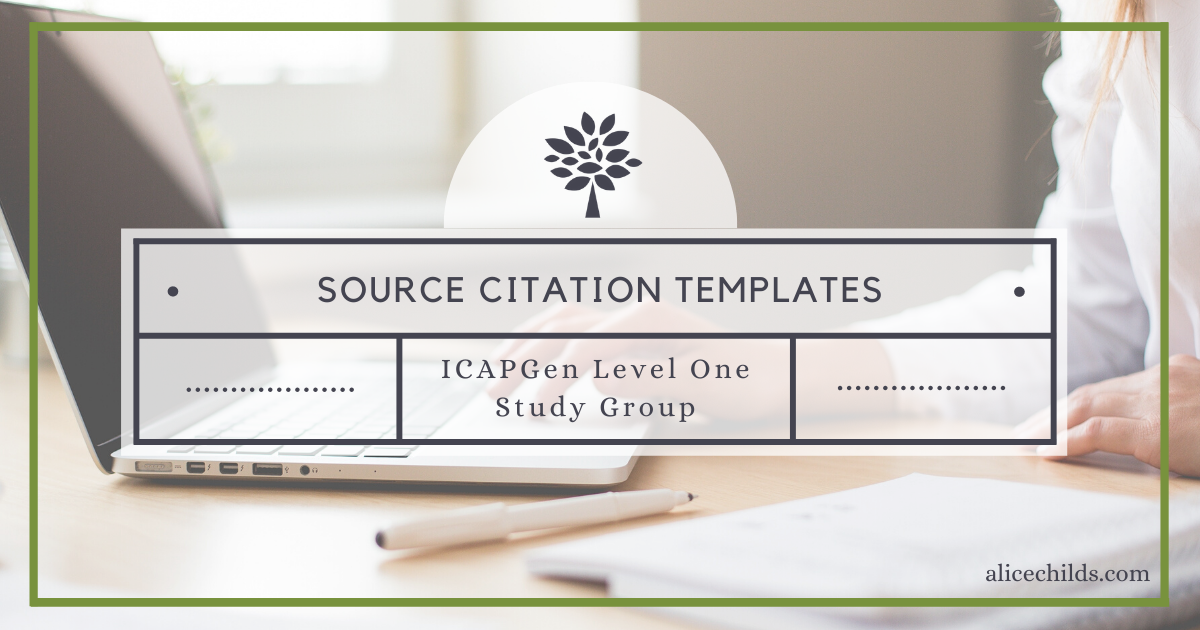
I am currently participating in the ICAPGen Level One Study group. Each participant in the group is preparing their four-generation project for submission. One of our first assignments was to fine-tune our source citation templates. The purpose of citation templates is two-fold. First, carefully crafted templates will save hours of time later. I won’t have to think about what to put in each citation. I will simply copy, paste, and quickly customize each citation as I fill out my research log. I can then copy and paste the citations from my research log into my reports as I am writing. Second, having templates and using them will ensure that my citations are consistent, which is one of the requirements for the Level One project submission.
I spent a fair amount of time going through each of my existing templates to make sure I had included the essential elements in each one. At the suggestion of the group leaders, I changed my templates from “examples” to true templates, with brackets around each piece of information that would change from citation to citation. Here’s an example:
My previous template for the 1880 U.S. census looked like this:
1880 U.S. census, Westmoreland County, Pennsylvania, population schedule, Hempfield Township, Stanton District, enumeration district (ED) 111, page 33A (stamped), page 1 (penned), dwelling 8, family 8, Hannah Beck in household of David Beck; digital image, FamilySearch (https://familysearch.org : accessed 7 May 2019); citing NARA microfilm publication T9, roll 1204.
My new 1880 census template looks like this:
(Template) 1880 U.S. census, [county] County, [state], population schedule, [civil divisions], enumeration district (ED) [#], page [#] (stamped), page [#] (penned), dwelling [#], family [#], [name]; digital image, FamilySearch (https://familysearch.org : accessed [date]); citing NARA microfilm publication TXXX, roll [#].
With this new format, I will be less likely to forget to replace key information as I am creating citations for reports. Everything within brackets needs to be replaced with the correct information from the source I am citing. After the citation is complete, I will delete the word “Template” from the beginning of the citation. I’m excited to have these templates and wanted to share a few with you. Copy and paste them into a chart or spreadsheet and you will have a great start for citation templates of your own.
United States Census Records
(Template) 1790 U.S. census, [county] County, [state], [civil division], page [#] (penned), column [#], line [#], [name]; digital image, Ancestry (https://ancestry.com : accessed [date]); citing NARA microfilm publication MXXX, roll [#].
(Template) 1850 U.S. census, [county] County, [state], population schedule, [civil division], page [#] (stamped), dwelling [#], family [#], [name]; digital image, FamilySearch (https://familysearch.org : accessed [date]); citing NARA microfilm publication MXXX, Roll [#].
(Template) 1920 U.S. census, [county] County, [state], population schedule, [civil divisions], enumeration district (ED) [#], page [#] (stamped), page [#] (penned), dwelling [#], family [#], [name]; digital image, Ancestry (https://ancestry.com : accessed [date]); citing NARA microfilm publication TXXX, roll [#].
Book and Chapter of a Book
(Template) [First and last name of author], [Title] ([Place of Publication]: [Publisher], [year]), [page].
(Template) [First and last name of chapter author], “[Chapter Title],” [Book Editors], ed., [Book Title] ([Place of Publication]: [Publisher], [year]), [page].
Find a Grave Memorial
(Template)Find a Grave, database with images, (https://www.findagrave.com : accessed [date]), memorial #[number], [name] ([dates]); citing [cemetery name], [city], [county] County, [state]; maintained by [name], contributor [number].
Database or Index – No Images
(Template) “[Database Title],” database, FamilySearch (https://familysearch.org : accessed [date]), entry for [name], [entry type], [date]; citing [source of the source]; FHL microfilm #[#].
Database With Images
(Template) [County] County, [State], [Record Type], [specific volume], page [#], [name], [record date]; database with images, “[Database Title],” [Website Title] ([URL] : accessed [date]), image [#].
Newspaper Article
(Template) [First and last name of author], “[Title] ([Subtitle]),” [Newspaper Title] ([city]), [date], page [#], column [#]; digital images, [Database Name] ([URL] : accessed [date]).
Online Tree
(Template) “Public Member Trees,” database, Ancestry (https://www.ancestry.com : accessed [date]), “[Tree Name]” managed by [manager], profile for [name] ([years of lifespan]), undocumented data.
Citing our sources is so important! It adds credibility to our research and makes it much easier for ourselves or someone else to retrace our steps. Whether you are new to source citations or are looking for a system to help you create citations more consistently, I hope you will find these citation templates useful.

These are great templates! I love the idea to turn them into true templates with the brackets. Thank you for sharing!
These are great! I will add them to my citation list that we started in our RLP class. Thanks for posting these for us to use.